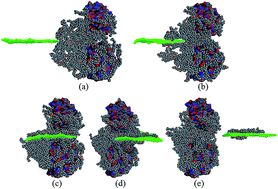Mechanisms of graphyne-enabled cholesterol extraction from protein clusters
Abstract
The health risk associated with high cholesterol levels in the human body has motivated intensive efforts to lower them by using specialized drugs. However, little research has been performed utilizing nanomaterials to remove extra cholesterol from living tissues. Graphyne, a 2D lattice of sp2- and sp1-hybridized carbons similar to graphene, possesses great potential for cholesterol extraction from cell membranes due to its distinct porous structure and outstanding surface adhesion. Here we employ molecular dynamics simulations to explore pathways for cholesterol removal from protein clusters by using graphyne as a promising vehicle. We first demonstrate the adhesive strength between a single cholesterol molecule and different types of pristine graphyne, which provides the foundation for the graphyne–cholesterol interaction and the dynamic cholesterol removal process within a protein cluster. The sp1-hybridized carbons in graphynes are potentially more reactive than the sp2-hybridized carbons in graphene, which bestows graphynes with a remarkable affinity for cholesterol molecules. Simulation results show that graphynes with more sp1-hybridized carbon linkers can extract more cholesterol molecules than those with fewer linkers. The movement rate of graphyne across the protein cluster also plays an important role in determining the amount of removed cholesterol molecules from the system of interest. The hybrid structure of graphyne with cholesterol molecules in its partial pores also possesses outstanding adhesive strength, showing better cholesterol removal performance than pristine graphyne. These findings open up a promising avenue to exploit the capability of graphyne for biomedical applications.


 Please wait while we load your content...
Please wait while we load your content...